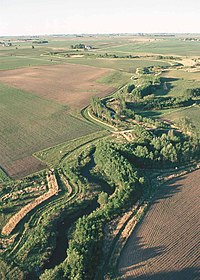
Photo from wikipedia
Simple Summary Beneficial insect numbers have sharply declined in recent years, and these declines negatively impact (1) food crops due to reduced pollination services, and (2) wildlife and birds due… Click to show full abstract
Simple Summary Beneficial insect numbers have sharply declined in recent years, and these declines negatively impact (1) food crops due to reduced pollination services, and (2) wildlife and birds due to reduced food sources. In part, agricultural intensification and habitat fragmentation have led to these declines. In the United States, one conservation effort is the Conservation Reserve Program (CRP), which provides financial assistance for replanting agricultural land to restored habitat to improve environmental health and quality. Common CRP grassland restorations are CP2 (“native grass” seed mix) and CP25 (“rare and declining habitat” seed mix). We examined the response of ground beetles, a group that is important for wildlife, to CRP restoration and management across three grassland habitats, and 108 sites. We examined two restoration types (CP2, CP25), and the grazing or absence of grazing by cattle. Our findings indicate that ground beetle communities are not negatively impacted by moderate levels of cattle grazing. Additionally, we found that cattle grazing might have positive effects on ground beetle abundance, biomass, and diversity in tallgrass habitats. The positive impact of cattle grazing may provide an additional incentive for CRP restorations that would enhance beneficial insect populations. Abstract Grasslands in North America have declined by over 70% since industrialization of settlements due to the conversion of natural habitats to cropland and urban centers. In the United States, the federally supported Conservation Reserve Program (CRP) was created to improve water quality, reduce soil erosion, and increase native habitats for wildlife. Within these restored grasslands, ground beetles (Coleoptera: Carabidae) are a keystone invertebrate group that fill several crucial niches and may serve as bioindicators of successful land management strategies. To understand the impact of land management on ground beetles, we examined carabid beetle community responses to a grazing treatment and two plant restoration treatments with low and relatively high initial plant diversity over two field seasons. We used pitfall traps at 108 CRP sites across a 63.5 cm precipitation gradient, encompassing three grassland types. Overall, grazing and restoration treatment did not have detectable effects on carabid abundance, biomass, or diversity. Carabid communities, however, responded differently to grazing within grassland types—all three community measures increased in response to grazing in tallgrass sites only. Our short-term study suggests that moderate levels of cattle grazing do not negatively affect carabid communities and might have positive effects on abundance, biomass, and diversity in tallgrass regions.
Journal Title: Insects
Year Published: 2022
Link to full text (if available)
Share on Social Media: Sign Up to like & get
recommendations!